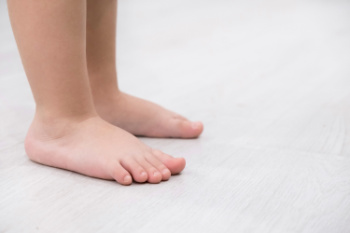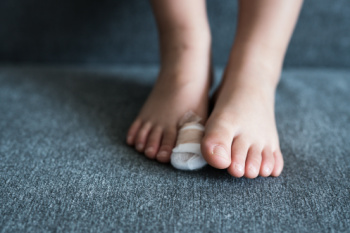
Flat feet, also known as fallen arches, are a common condition where the arches of the feet touch the ground when standing. While it is normal for babies and toddlers to have flat feet due to underdeveloped arches, most children develop arches by the age of six. However, some children continue to have flat feet into adolescence and adulthood. In many cases, flat feet do not cause any problems or require treatment, although some children may experience foot pain, stiffness, or difficulty with activities like running or sports. It is important for parents to monitor their child's foot development and seek medical attention if they have concerns about flat feet. A podiatrist can assess the child's feet and recommend appropriate interventions, such as wearing supportive footwear or custom orthotic inserts. By understanding flat feet and seeking timely intervention when needed, parents can help ensure their child's foot health and overall well-being. If your child has maintained flat feet beyond the age of six, it is strongly suggested that you confer with a podiatrist who can monitor your child’s condition.
Flatfoot is a condition many people suffer from. If you have flat feet, contact Braden Jenkins, DPM from The Ridge Foot & Ankle Center. Our doctor will treat your foot and ankle needs.
What Are Flat Feet?
Flatfoot is a condition in which the arch of the foot is depressed and the sole of the foot is almost completely in contact with the ground. About 20-30% of the population generally has flat feet because their arches never formed during growth.
Conditions & Problems:
Having flat feet makes it difficult to run or walk because of the stress placed on the ankles.
Alignment – The general alignment of your legs can be disrupted, because the ankles move inward which can cause major discomfort.
Knees – If you have complications with your knees, flat feet can be a contributor to arthritis in that area.
Symptoms
- Pain around the heel or arch area
- Trouble standing on the tip toe
- Swelling around the inside of the ankle
- Flat look to one or both feet
- Having your shoes feel uneven when worn
Treatment
If you are experiencing pain and stress on the foot you may weaken the posterior tibial tendon, which runs around the inside of the ankle.
If you have any questions please feel free to contact our office located in Idaho Falls, ID . We offer the newest diagnostic and treatment technologies for all your foot and ankle needs.

Toe fractures, though often overlooked, can cause significant discomfort and inconvenience. Whether it is the big toe or one of the smaller ones, any part of the toe can become fractured due to trauma or repetitive stress. Symptoms typically include pain, swelling, bruising, and difficulty bearing weight. In severe cases, the toe may appear deformed or misaligned. Diagnosing a toe fracture involves a thorough physical examination and possibly imaging tests such as X-rays. Your podiatrist will assess the extent of the injury and determine the best course of treatment, which may include rest, elevation, and immobilization with a splint or buddy taping. In some cases, if the fracture is severe or displaced, surgery may be necessary to realign the bones and promote proper healing. If you have symptoms of a broken toe, it is suggested that you seek prompt medical attention from a podiatrist who can effectively treat this condition.
A broken toe can be very painful and lead to complications if not properly fixed. If you have any concerns about your feet, contact Braden Jenkins, DPM from The Ridge Foot & Ankle Center. Our doctor will treat your foot and ankle needs.
What to Know About a Broken Toe
Although most people try to avoid foot trauma such as banging, stubbing, or dropping heavy objects on their feet, the unfortunate fact is that it is a common occurrence. Given the fact that toes are positioned in front of the feet, they typically sustain the brunt of such trauma. When trauma occurs to a toe, the result can be a painful break (fracture).
Symptoms of a Broken Toe
- Throbbing pain
- Swelling
- Bruising on the skin and toenail
- The inability to move the toe
- Toe appears crooked or disfigured
- Tingling or numbness in the toe
Generally, it is best to stay off of the injured toe with the affected foot elevated.
Severe toe fractures may be treated with a splint, cast, and in some cases, minor surgery. Due to its position and the pressure it endures with daily activity, future complications can occur if the big toe is not properly treated.
If you have any questions please feel free to contact our office located in Idaho Falls, ID . We offer the newest diagnostic and treatment technologies for all your foot and ankle needs.

Morton's neuroma, a painful condition characterized by thickening of the tissue around a nerve leading to the toes, can significantly impact mobility and quality of life. When conservative treatments fail to provide adequate relief, surgical intervention becomes a viable option. The surgical approach aims to decompress the affected nerve and remove the enlarged tissue causing compression and discomfort. Typically performed under local anesthesia, surgical techniques vary depending on the severity of the neuroma and individual patient factors. Common procedures include neurectomy, wherein the affected nerve segment is excised, or decompression, which involves releasing pressure on the nerve through various means. Minimally invasive techniques, such as endoscopic decompression, offer reduced recovery times and fewer complications compared to traditional open surgery. While surgery for Morton's neuroma carries risks like any other procedure, it can offer significant relief from persistent pain and allow individuals to regain mobility and resume daily activities with greater comfort and ease. If you have Morton’s neuroma and are considering surgery for relief, it is suggested that you consult a podiatrist who can determine if this is the right choice for you.
Foot surgery is sometimes necessary to treat a foot ailment. To learn more, contact Braden Jenkins, DPM of The Ridge Foot & Ankle Center. Our doctor will assist you with all of your foot and ankle needs.
When Is Surgery Necessary?
Foot and ankle surgery is generally reserved for cases in which less invasive, conservative procedures have failed to alleviate the problem. Some of the cases in which surgery may be necessary include:
- Removing foot deformities like bunions and bone spurs
- Severe arthritis that has caused bone issues
- Cosmetic reconstruction
What Types of Surgery Are There?
The type of surgery you receive will depend on the nature of the problem you have. Some of the possible surgeries include:
- Bunionectomy for painful bunions
- Surgical fusion for realignment of bones
- Neuropathy decompression surgery to treat nerve damage
Benefits of Surgery
Although surgery is usually a last resort, it can provide more complete pain relief compared to non-surgical methods and may allow you to finally resume full activity.
Surgical techniques have also become increasingly sophisticated. Techniques like endoscopic surgery allow for smaller incisions and faster recovery times.
If you have any questions please feel free to contact our office located in Idaho Falls, ID . We offer the newest diagnostic and treatment technologies for all your foot and ankle needs.

Baseball, a sport known for its agility and athleticism, can exert significant strain on the feet and ankles of players. The repetitive motions involved in running, pivoting, and sliding can lead to various foot and ankle injuries. Ankle sprains are a common occurrence, resulting from sudden twists or turns during gameplay. Additionally, the forceful impact of running and jumping can cause stress fractures in the feet, particularly in the metatarsal bones. Baseball players are also susceptible to conditions like plantar fasciitis due to the repetitive stress placed on the arches while running and batting. Furthermore, cleats worn during gameplay can contribute to foot discomfort and blisters, especially if not properly fitted or worn for extended periods. To manage these risks, it is helpful for players to prioritize proper warm-up routines, wear supportive footwear, and seek prompt medical attention for any signs of injury to ensure optimal foot and ankle health throughout their baseball careers. If you have endured a foot or ankle injury while playing baseball, it is suggested that you schedule an appointment with a podiatrist who can properly treat an array of foot conditions.
Ankle and foot injuries are common among athletes and in many sports. They can be caused by several problems and may be potentially serious. If you are feeling pain or think you were injured in a sporting event or when exercising, consult with Braden Jenkins, DPM from The Ridge Foot & Ankle Center. Our doctor will assess your condition and provide you with quality foot and ankle treatment.
Common Injuries
The most common injuries that occur in sporting activities include:
- Achilles Tendonitis
- Achilles Tendon Rupture
- Ankle Sprains
- Broken Foot
- Plantar Fasciitis
- Stress Fractures
- Turf Toe
Symptoms
Symptoms vary depending upon the injury and in some cases, there may be no symptoms at all. However, in most cases, some form of symptom is experienced. Pain, aching, burning, bruising, tenderness, tightness or stiffness, sensation loss, difficulty moving, and swelling are the most common symptoms.
Treatment
Just as symptoms vary depending upon the injury, so do treatment options. A common treatment method is known as the RICE method. This method involves rest, applying ice, compression and elevating the afflicted foot or ankle. If the injury appears to be more serious, surgery might be required, such as arthroscopic or reconstructive surgery. Lastly, rehabilitation or therapy might be needed to gain full functionality in the afflicted area. Any discomfort experienced by an athlete must be evaluated by a licensed, reputable medical professional.
If you have any questions, please feel free to contact our office located in Idaho Falls, ID . We offer the newest diagnostic and treatment technologies for all your foot care needs.
